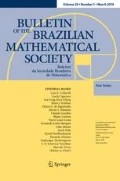Abstract
In this paper we study a system which we propose as a model to describe the interaction between matter and electromagnetic field from a dualistic point of view. This system arises from a suitable coupling of the Schrödinger and the Born–Infeld agrangians, this latter replacing the role that, classically, is played by the Maxwell Lagrangian. We use a variational approach to find an electrostatic radial ground state solution by means of suitable estimates on the functional of the action.
Similar content being viewed by others
References
Azzollini, A., Benci, V., D’Aprile, T., Fortunato, D.: Existence of static solutions of the semilinear Maxwell equations. Ric. Mat. 55, 283–297 (2006)
Benci, V., Fortunato, D.: An eigenvalue problem for the Schrödinger–Maxwell equations. Topol. Methods Nonlinear Anal. 11, 283–293 (1998)
Benci, V., Fortunato, D.: Solitary waves of the nonlinear Klein–Gordon field equation coupled with the Maxwell equations. Rev. Math. Phys. 14, 409–420 (2002)
Benci, V., Fortunato, D.: Towards a unified field theory for classical electrodynamics. Arch. Ration. Mech. Anal. 173, 379–414 (2004)
Berestycki, H., Lions, P.L.: Nonlinear scalar field equations. I. Existence of a ground state. Arch. Ration. Mech. Anal. 82, 313–345 (1983)
Bonheure, D., d’Avenia, P., Pomponio, A.: On the electrostatic Born–Infeld equation with extended charges. Commun. Math. Phys. 346, 877–906 (2016)
Born, M., Infeld, L.: Foundations of the new field theory. Nature 132, 1004 (1933)
Born, M., Infeld, L.: Foundations of the new field theory. Proc. Roy. Soc. Lond. Ser. A 144, 425–451 (1934)
Benmilh, K., Kavian, O.: Existence and asymptotic behaviour of standing waves for quasilinear Schrödinger–Poisson systems in \({\mathbb{R}^3}\). Ann. I. H. Poincarè 25, 449–470 (2008)
D’Aprile, T., Mugnai, D.: Solitary waves for nonlinear Klein-Gordon-Maxwell and Schrödinger-Maxwell equations. Proc. R. Soc. Edinb. Sect. A 134, 893–906 (2004a)
D’Aprile, T., Mugnai, D.: Non-existence results for the coupled Klein–Gordon–Maxwell equations. Adv. Nonlinear Stud. 4, 307–322 (2004b)
D’Aprile, T., Siciliano, G.: Magnetostatic solutions for a semilinear perturbation of the Maxwell equations. Adv. Differ. Equ. 16, 435–466 (2011)
d’Avenia, P., Pisani, L.: Nonlinear Klein-Gordon equations coupled with Born-Infeld type equations. Electron. J. Differ. Equ. 2002(26), 1–13 (2002)
Jeanjean, L.: On the existence of bounded Palais–Smale sequences and application to a Landesman-Lazer-type problem set on \({\mathbb{R}}\). Proc. R. Soc. Edinb. 129A, 787–809 (1999)
Struwe, M.: On the evolution of harmonic mappings of Riemannian surfaces. Comment. Math. Helv. 60, 558–581 (1985)
Yu, Y.: Solitary waves for nonlinear Klein–Gordon equations coupled with Born–Infeld theory. Ann. Inst. H. Poincaré Anal. Non Linéaire 27, 351–376 (2010)
Author information
Authors and Affiliations
Corresponding author
Additional information
A. Azzollini and A. Pomponio are partially supported by a grant of the group GNAMPA of INDAM. A. Pomponio is partially supported also by FRA2016 of Politecnico di Bari. G. Siciliano is supported by Capes, CNPq Grant 305616/2015-3 and Fapesp grant 2016/02617-3, Brazil.
About this article
Cite this article
Azzollini, A., Pomponio, A. & Siciliano, G. On the Schrödinger–Born–Infeld System. Bull Braz Math Soc, New Series 50, 275–289 (2019). https://doi.org/10.1007/s00574-018-0111-y
Received:
Accepted:
Published:
Issue Date:
DOI: https://doi.org/10.1007/s00574-018-0111-y


